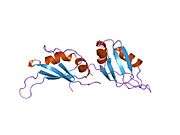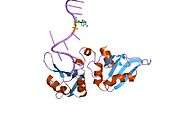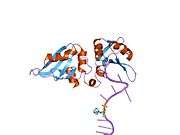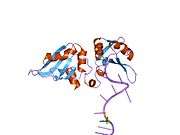Heterogeneous nuclear ribonucleoprotein A1
| View/Edit Human | |||
Heterogeneous nuclear ribonucleoprotein A1 is a protein that in humans is encoded by the HNRNPA1 gene.[2] Mutations in HNRNPA1 are causative of the syndrome multisystem proteinopathy.
Function
This gene belongs to the A/B subfamily of ubiquitously expressed heterogeneous nuclear ribonucleoproteins (hnRNPs). The hnRNPs are RNA binding proteins and they complex with heterogeneous nuclear RNA (hnRNA). These proteins are associated with pre-mRNAs in the nucleus and appear to influence pre-mRNA processing and other aspects of mRNA metabolism and transport. While all of the hnRNPs are present in the nucleus, some seem to shuttle between the nucleus and the cytoplasm. The hnRNP proteins have distinct nucleic acid binding properties. The protein encoded by this gene has two repeats of quasi-RRM domains that bind to RNAs. It is one of the most abundant core proteins of hnRNP complexes and it is localized to the nucleoplasm. This protein, along with other hnRNP proteins, is exported from the nucleus, probably bound to mRNA, and is immediately re-imported. Its M9 domain acts as both a nuclear localization and nuclear export signal. The encoded protein is involved in the packaging of pre-mRNA into hnRNP particles, transport of poly A+ mRNA from the nucleus to the cytoplasm, and may modulate splice site selection. Multiple alternatively spliced transcript variants have been found for this gene but only two transcripts are fully described. These variants have multiple alternative transcription initiation sites and multiple polyA sites.[3]
Interactions
Heterogeneous nuclear ribonucleoprotein A1 has been shown to interact with BAT2,[4] Flap structure-specific endonuclease 1[5] and IκBα.[6]
Role in disease
Mutations in hnRNP A1 are a cause of amyotrophic lateral sclerosis and multisystem proteinopathy.
References
- ↑ "Human PubMed Reference:".
- ↑ Saccone S, Biamonti G, Maugeri S, Bassi MT, Bunone G, Riva S, Della Valle G (Mar 1992). "Assignment of the human heterogeneous nuclear ribonucleoprotein A1 gene (HNRPA1) to chromosome 12q13.1 by cDNA competitive in situ hybridization". Genomics. 12 (1): 171–4. doi:10.1016/0888-7543(92)90424-Q. PMID 1733858.
- ↑ "Entrez Gene: HNRPA1 heterogeneous nuclear ribonucleoprotein A1".
- ↑ Lehner B, Semple JI, Brown SE, Counsell D, Campbell RD, Sanderson CM (Jan 2004). "Analysis of a high-throughput yeast two-hybrid system and its use to predict the function of intracellular proteins encoded within the human MHC class III region". Genomics. 83 (1): 153–67. doi:10.1016/S0888-7543(03)00235-0. PMID 14667819.
- ↑ Chai Q, Zheng L, Zhou M, Turchi JJ, Shen B (Dec 2003). "Interaction and stimulation of human FEN-1 nuclease activities by heterogeneous nuclear ribonucleoprotein A1 in alpha-segment processing during Okazaki fragment maturation". Biochemistry. 42 (51): 15045–52. doi:10.1021/bi035364t. PMID 14690413.
- ↑ Hay DC, Kemp GD, Dargemont C, Hay RT (May 2001). "Interaction between hnRNPA1 and IkappaBalpha is required for maximal activation of NF-kappaB-dependent transcription". Mol. Cell. Biol. 21 (10): 3482–90. doi:10.1128/MCB.21.10.3482-3490.2001. PMC 100270
 . PMID 11313474.
. PMID 11313474.
Further reading
- Kim S, Park GH, Paik WK (1999). "Recent advances in protein methylation: enzymatic methylation of nucleic acid binding proteins.". Amino Acids. 15 (4): 291–306. doi:10.1007/BF01320895. PMID 9891755.
- Buvoli M, Cobianchi F, Bestagno MG, Mangiarotti A, Bassi MT, Biamonti G, Riva S (1990). "Alternative splicing in the human gene for the core protein A1 generates another hnRNP protein.". EMBO J. 9 (4): 1229–35. PMC 551799
 . PMID 1691095.
. PMID 1691095. - Ghetti A, Bolognesi M, Cobianchi F, Morandi C (1991). "Modeling by homology of RNA binding domain in A1 hnRNP protein.". FEBS Lett. 277 (1-2): 272–6. doi:10.1016/0014-5793(90)80863-E. PMID 2176620.
- Biamonti G, Buvoli M, Bassi MT, Morandi C, Cobianchi F, Riva S (1989). "Isolation of an active gene encoding human hnRNP protein A1. Evidence for alternative splicing.". J. Mol. Biol. 207 (3): 491–503. doi:10.1016/0022-2836(89)90459-2. PMID 2760922.
- Buvoli M, Biamonti G, Tsoulfas P, Bassi MT, Ghetti A, Riva S, Morandi C (1988). "cDNA cloning of human hnRNP protein A1 reveals the existence of multiple mRNA isoforms.". Nucleic Acids Res. 16 (9): 3751–70. doi:10.1093/nar/16.9.3751. PMC 336554
 . PMID 2836799.
. PMID 2836799. - Riva S, Morandi C, Tsoulfas P, Pandolfo M, Biamonti G, Merrill B, Williams KR, Multhaup G, Beyreuther K, Werr H (1986). "Mammalian single-stranded DNA binding protein UP I is derived from the hnRNP core protein A1.". EMBO J. 5 (9): 2267–73. PMC 1167110
 . PMID 3023065.
. PMID 3023065. - Epplen C, Epplen JT (1994). "Expression of (cac)n/(gtg)n simple repetitive sequences in mRNA of human lymphocytes.". Hum. Genet. 93 (1): 35–41. doi:10.1007/BF00218910. PMID 7505766.
- Siomi H, Dreyfuss G (1995). "A nuclear localization domain in the hnRNP A1 protein.". J. Cell Biol. 129 (3): 551–60. doi:10.1083/jcb.129.3.551. PMC 2120450
 . PMID 7730395.
. PMID 7730395. - Weighardt F, Biamonti G, Riva S (1995). "Nucleo-cytoplasmic distribution of human hnRNP proteins: a search for the targeting domains in hnRNP A1.". J. Cell. Sci. 108 (2): 545–55. PMID 7769000.
- Rajpurohit R, Lee SO, Park JO, Paik WK, Kim S (1994). "Enzymatic methylation of recombinant heterogeneous nuclear RNP protein A1. Dual substrate specificity for S-adenosylmethionine:histone-arginine N-methyltransferase.". J. Biol. Chem. 269 (2): 1075–82. PMID 8288564.
- Hamilton BJ, Nagy E, Malter JS, Arrick BA, Rigby WF (1993). "Association of heterogeneous nuclear ribonucleoprotein A1 and C proteins with reiterated AUUUA sequences.". J. Biol. Chem. 268 (12): 8881–7. PMID 8473331.
- Michael WM, Choi M, Dreyfuss G (1996). "A nuclear export signal in hnRNP A1: a signal-mediated, temperature-dependent nuclear protein export pathway.". Cell. 83 (3): 415–22. doi:10.1016/0092-8674(95)90119-1. PMID 8521471.
- Black AC, Luo J, Chun S, Bakker A, Fraser JK, Rosenblatt JD (1997). "Specific binding of polypyrimidine tract binding protein and hnRNP A1 to HIV-1 CRS elements.". Virus Genes. 12 (3): 275–85. doi:10.1007/bf00284648. PMID 8883365.
- Bonaldo MF, Lennon G, Soares MB (1997). "Normalization and subtraction: two approaches to facilitate gene discovery.". Genome Res. 6 (9): 791–806. doi:10.1101/gr.6.9.791. PMID 8889548.
- Xu RM, Jokhan L, Cheng X, Mayeda A, Krainer AR (1997). "Crystal structure of human UP1, the domain of hnRNP A1 that contains two RNA-recognition motifs.". Structure. 5 (4): 559–70. doi:10.1016/S0969-2126(97)00211-6. PMID 9115444.
- Bonifaci N, Moroianu J, Radu A, Blobel G (1997). "Karyopherin beta2 mediates nuclear import of an mRNA binding protein.". Proc. Natl. Acad. Sci. U.S.A. 94 (10): 5055–60. doi:10.1073/pnas.94.10.5055. PMC 24630
 . PMID 9144189.
. PMID 9144189. - Shamoo Y, Krueger U, Rice LM, Williams KR, Steitz TA (1997). "Crystal structure of the two RNA binding domains of human hnRNP A1 at 1.75 A resolution.". Nat. Struct. Biol. 4 (3): 215–22. doi:10.1038/nsb0397-215. PMID 9164463.
- Neubauer G, King A, Rappsilber J, Calvio C, Watson M, Ajuh P, Sleeman J, Lamond A, Mann M (1998). "Mass spectrometry and EST-database searching allows characterization of the multi-protein spliceosome complex.". Nat. Genet. 20 (1): 46–50. doi:10.1038/1700. PMID 9731529.















